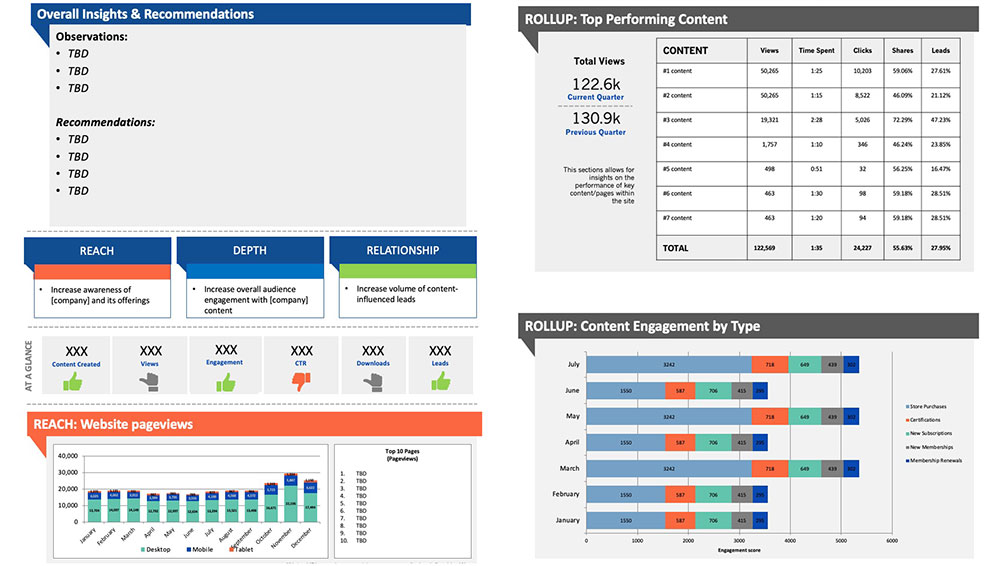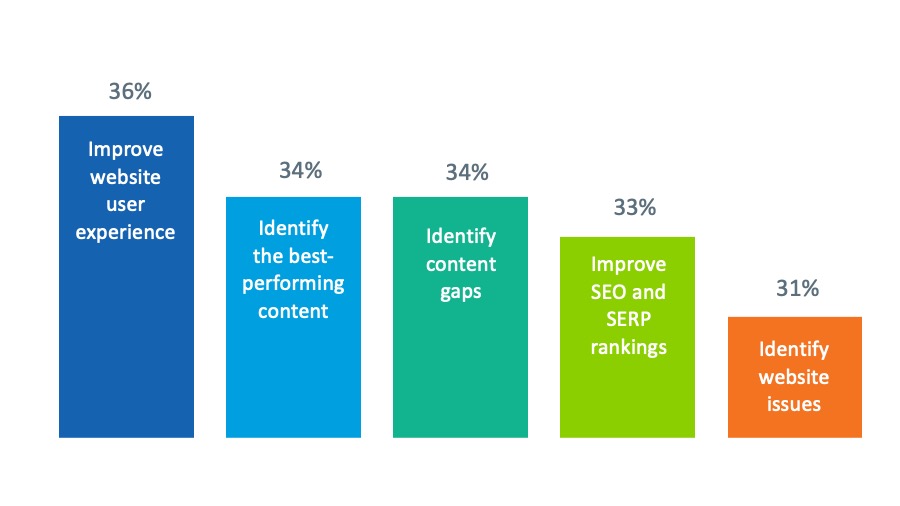Monthly qualitative audits: Reviewing and optimizing your content on a monthly or quarterly basis can help you improve its performance and SEO rank over time. A simple measurement dashboard (see below) can enhance this process, assessing quantitative SEO and performance data to give you actionable insights. Use those insights to continually optimize your content over time.

In-depth content scoring: The real magic happens when you assess and score content quantitatively and qualitatively. That’s the essence of Tendo’s proprietary content scorecard. Robots and humans tag-team the audit: Robots digest the performance metrics and humans assess whether a given piece of content sucks or scores a home run. Humans are especially awesome at evaluating a given piece of content across factors like effectiveness, discoverability, relevance, and brand consistency.
Full content scoring is obviously a heavier lift, so you can’t do it as often (we suggest tackling content in batches every six month). But the deeper insights you gain can lay the groundwork for a more effective content marketing plan or content strategy roadmap.

Talk to Tendo about Content Scoring
Learn more about how to set up a content scorecard on your own, or talk to us about how we can help.
Content saturation is real: Marketers have correctly embraced the idea that content drives the customer journey. So they created content in spades, and it worked. Then the pandemic came along and digital content consumption accelerated further; marketers revved their content engines to keep up. In 2022, many organizations now see that their content libraries are massive, perhaps even bloated. Many of those assets are still fresh and effective, but others have gone stale, or never performed well to begin with. To find out—and to devise a smart content strategy moving forward—you need to dive into an audit first.
Content ROI recognition: As more content marketers seek to measure content ROI, they’re seeing the value of an audit. A content audit can illuminate not just what content performs well and why, but whether the “juice was worth the squeeze,” i.e., return on investment. An audit can help you focus your marketing budget on creating the types of content that are already resonating and generating results, as well as the content that is ripe for repurposing. So a content audit definitely delivers its own ROI, and marketers recognize that.

One Last Thing: Not All Audits Are the Same
With more organizations prioritizing content audits—and running them more often—it’s important to note that not everyone defines an audit the same way. For example, HubSpot reports that 30% of marketers and media planners run audits monthly. But that’s just not practical if you’re performing a detailed audit in the way that Tendo prescribes.
Here are two complementary audit approaches:
Monthly qualitative audits: Reviewing and optimizing your content on a monthly or quarterly basis can help you improve its performance and SEO rank over time. A simple measurement dashboard (see below) can enhance this process, assessing quantitative SEO and performance data to give you actionable insights. Use those insights to continually optimize your content over time.

In-depth content scoring: The real magic happens when you assess and score content quantitatively and qualitatively. That’s the essence of Tendo’s proprietary content scorecard. Robots and humans tag-team the audit: Robots digest the performance metrics and humans assess whether a given piece of content sucks or scores a home run. Humans are especially awesome at evaluating a given piece of content across factors like effectiveness, discoverability, relevance, and brand consistency.
Full content scoring is obviously a heavier lift, so you can’t do it as often (we suggest tackling content in batches every six month). But the deeper insights you gain can lay the groundwork for a more effective content marketing plan or content strategy roadmap.

Talk to Tendo about Content Scoring
Learn more about how to set up a content scorecard on your own, or talk to us about how we can help.
Top 5 Content Audit Benefits
Why are more marketers running audits? HubSpot’s report uncovered five motivations among survey respondents. These benefits focus on websites, but can apply to all marketing content:

At the end of the day, a content audit helps you see what’s working and what’s missing the mark. When you evaluate and score your content—from blog posts to ebooks and white papers—the discoveries will often surprise you:
- Hidden gems of content that have outstanding quality but poor performance because they’re too hard to find on your website
- A wealth of awareness-stage content to attract and educate readers, but a dearth of decision-stage content to help them close the deal and become your customer
- Major gaps in content that speak to the needs of an important target audience or industry segment
- Poor ranking versus your competitors on critical SEO keywords
- Older content that you forgot existed and needs to be tossed, like expired food at the back of your refrigerator
Something Deeper Is Driving This Trend
Why do marketers finally grasp the value and importance of content audits in 2022, when they didn’t seem to get it six years ago? Three thoughts come to mind:
The message has been on repeat: Marketing thought leaders have continually preached the importance of evaluating and optimizing your existing content. Now it’s finally sinking in. Lindy Roux, Tendo’s executive vice president and partner, summed it up this way: You must build content scoring and optimization into your workflow. It ain’t optional anymore.
Content saturation is real: Marketers have correctly embraced the idea that content drives the customer journey. So they created content in spades, and it worked. Then the pandemic came along and digital content consumption accelerated further; marketers revved their content engines to keep up. In 2022, many organizations now see that their content libraries are massive, perhaps even bloated. Many of those assets are still fresh and effective, but others have gone stale, or never performed well to begin with. To find out—and to devise a smart content strategy moving forward—you need to dive into an audit first.
Content ROI recognition: As more content marketers seek to measure content ROI, they’re seeing the value of an audit. A content audit can illuminate not just what content performs well and why, but whether the “juice was worth the squeeze,” i.e., return on investment. An audit can help you focus your marketing budget on creating the types of content that are already resonating and generating results, as well as the content that is ripe for repurposing. So a content audit definitely delivers its own ROI, and marketers recognize that.

One Last Thing: Not All Audits Are the Same
With more organizations prioritizing content audits—and running them more often—it’s important to note that not everyone defines an audit the same way. For example, HubSpot reports that 30% of marketers and media planners run audits monthly. But that’s just not practical if you’re performing a detailed audit in the way that Tendo prescribes.
Here are two complementary audit approaches:
Monthly qualitative audits: Reviewing and optimizing your content on a monthly or quarterly basis can help you improve its performance and SEO rank over time. A simple measurement dashboard (see below) can enhance this process, assessing quantitative SEO and performance data to give you actionable insights. Use those insights to continually optimize your content over time.

In-depth content scoring: The real magic happens when you assess and score content quantitatively and qualitatively. That’s the essence of Tendo’s proprietary content scorecard. Robots and humans tag-team the audit: Robots digest the performance metrics and humans assess whether a given piece of content sucks or scores a home run. Humans are especially awesome at evaluating a given piece of content across factors like effectiveness, discoverability, relevance, and brand consistency.
Full content scoring is obviously a heavier lift, so you can’t do it as often (we suggest tackling content in batches every six month). But the deeper insights you gain can lay the groundwork for a more effective content marketing plan or content strategy roadmap.

Talk to Tendo about Content Scoring
Learn more about how to set up a content scorecard on your own, or talk to us about how we can help.
- 81% of content marketers and media planners who conduct audits say they have been effective for shaping their content and media planning strategies, and, in turn, reaching their business goals, according to HubSpot’s new 2022 research report, The State of Media and Content Planning.
- 65% of companies that succeed in content marketing run content audits more than twice a year, according to SEMrush’s State of Content Marketing 2022 Global Report.
- Content audit initiatives will grow significantly in 2022, predicts HubSpot: 37% of content marketers and media planners plan to run audits for the first time in 2022 and 15% will invest more in audits than any other strategy.
From the agency perspective, HubSpot’s prediction rings true: Tendo is definitely seeing an uptick in content audit requests from our B2B clients.
Top 5 Content Audit Benefits
Why are more marketers running audits? HubSpot’s report uncovered five motivations among survey respondents. These benefits focus on websites, but can apply to all marketing content:

At the end of the day, a content audit helps you see what’s working and what’s missing the mark. When you evaluate and score your content—from blog posts to ebooks and white papers—the discoveries will often surprise you:
- Hidden gems of content that have outstanding quality but poor performance because they’re too hard to find on your website
- A wealth of awareness-stage content to attract and educate readers, but a dearth of decision-stage content to help them close the deal and become your customer
- Major gaps in content that speak to the needs of an important target audience or industry segment
- Poor ranking versus your competitors on critical SEO keywords
- Older content that you forgot existed and needs to be tossed, like expired food at the back of your refrigerator
Something Deeper Is Driving This Trend
Why do marketers finally grasp the value and importance of content audits in 2022, when they didn’t seem to get it six years ago? Three thoughts come to mind:
The message has been on repeat: Marketing thought leaders have continually preached the importance of evaluating and optimizing your existing content. Now it’s finally sinking in. Lindy Roux, Tendo’s executive vice president and partner, summed it up this way: You must build content scoring and optimization into your workflow. It ain’t optional anymore.
Content saturation is real: Marketers have correctly embraced the idea that content drives the customer journey. So they created content in spades, and it worked. Then the pandemic came along and digital content consumption accelerated further; marketers revved their content engines to keep up. In 2022, many organizations now see that their content libraries are massive, perhaps even bloated. Many of those assets are still fresh and effective, but others have gone stale, or never performed well to begin with. To find out—and to devise a smart content strategy moving forward—you need to dive into an audit first.
Content ROI recognition: As more content marketers seek to measure content ROI, they’re seeing the value of an audit. A content audit can illuminate not just what content performs well and why, but whether the “juice was worth the squeeze,” i.e., return on investment. An audit can help you focus your marketing budget on creating the types of content that are already resonating and generating results, as well as the content that is ripe for repurposing. So a content audit definitely delivers its own ROI, and marketers recognize that.

One Last Thing: Not All Audits Are the Same
With more organizations prioritizing content audits—and running them more often—it’s important to note that not everyone defines an audit the same way. For example, HubSpot reports that 30% of marketers and media planners run audits monthly. But that’s just not practical if you’re performing a detailed audit in the way that Tendo prescribes.
Here are two complementary audit approaches:
Monthly qualitative audits: Reviewing and optimizing your content on a monthly or quarterly basis can help you improve its performance and SEO rank over time. A simple measurement dashboard (see below) can enhance this process, assessing quantitative SEO and performance data to give you actionable insights. Use those insights to continually optimize your content over time.

In-depth content scoring: The real magic happens when you assess and score content quantitatively and qualitatively. That’s the essence of Tendo’s proprietary content scorecard. Robots and humans tag-team the audit: Robots digest the performance metrics and humans assess whether a given piece of content sucks or scores a home run. Humans are especially awesome at evaluating a given piece of content across factors like effectiveness, discoverability, relevance, and brand consistency.
Full content scoring is obviously a heavier lift, so you can’t do it as often (we suggest tackling content in batches every six month). But the deeper insights you gain can lay the groundwork for a more effective content marketing plan or content strategy roadmap.

Talk to Tendo about Content Scoring
Learn more about how to set up a content scorecard on your own, or talk to us about how we can help.
Content audits used be seen as more of a nice-to-have, optional component of a content marketing strategy. Back in 2016, a Curata survey showed that most marketers were not regularly auditing their content, and 37% had never attempted a content audit, not even once.
So much has changed. Successful marketers now rank content audits—defined as an analysis of all digital content—as one of their most necessary and impactful tactics, according to two recent reports. But why the dramatic shift?
Marketers Consider Content Audits a Top Marketing Tactic
- 81% of content marketers and media planners who conduct audits say they have been effective for shaping their content and media planning strategies, and, in turn, reaching their business goals, according to HubSpot’s new 2022 research report, The State of Media and Content Planning.
- 65% of companies that succeed in content marketing run content audits more than twice a year, according to SEMrush’s State of Content Marketing 2022 Global Report.
- Content audit initiatives will grow significantly in 2022, predicts HubSpot: 37% of content marketers and media planners plan to run audits for the first time in 2022 and 15% will invest more in audits than any other strategy.
From the agency perspective, HubSpot’s prediction rings true: Tendo is definitely seeing an uptick in content audit requests from our B2B clients.
Top 5 Content Audit Benefits
Why are more marketers running audits? HubSpot’s report uncovered five motivations among survey respondents. These benefits focus on websites, but can apply to all marketing content:

At the end of the day, a content audit helps you see what’s working and what’s missing the mark. When you evaluate and score your content—from blog posts to ebooks and white papers—the discoveries will often surprise you:
- Hidden gems of content that have outstanding quality but poor performance because they’re too hard to find on your website
- A wealth of awareness-stage content to attract and educate readers, but a dearth of decision-stage content to help them close the deal and become your customer
- Major gaps in content that speak to the needs of an important target audience or industry segment
- Poor ranking versus your competitors on critical SEO keywords
- Older content that you forgot existed and needs to be tossed, like expired food at the back of your refrigerator
Something Deeper Is Driving This Trend
Why do marketers finally grasp the value and importance of content audits in 2022, when they didn’t seem to get it six years ago? Three thoughts come to mind:
The message has been on repeat: Marketing thought leaders have continually preached the importance of evaluating and optimizing your existing content. Now it’s finally sinking in. Lindy Roux, Tendo’s executive vice president and partner, summed it up this way: You must build content scoring and optimization into your workflow. It ain’t optional anymore.
Content saturation is real: Marketers have correctly embraced the idea that content drives the customer journey. So they created content in spades, and it worked. Then the pandemic came along and digital content consumption accelerated further; marketers revved their content engines to keep up. In 2022, many organizations now see that their content libraries are massive, perhaps even bloated. Many of those assets are still fresh and effective, but others have gone stale, or never performed well to begin with. To find out—and to devise a smart content strategy moving forward—you need to dive into an audit first.
Content ROI recognition: As more content marketers seek to measure content ROI, they’re seeing the value of an audit. A content audit can illuminate not just what content performs well and why, but whether the “juice was worth the squeeze,” i.e., return on investment. An audit can help you focus your marketing budget on creating the types of content that are already resonating and generating results, as well as the content that is ripe for repurposing. So a content audit definitely delivers its own ROI, and marketers recognize that.

One Last Thing: Not All Audits Are the Same
With more organizations prioritizing content audits—and running them more often—it’s important to note that not everyone defines an audit the same way. For example, HubSpot reports that 30% of marketers and media planners run audits monthly. But that’s just not practical if you’re performing a detailed audit in the way that Tendo prescribes.
Here are two complementary audit approaches:
Monthly qualitative audits: Reviewing and optimizing your content on a monthly or quarterly basis can help you improve its performance and SEO rank over time. A simple measurement dashboard (see below) can enhance this process, assessing quantitative SEO and performance data to give you actionable insights. Use those insights to continually optimize your content over time.

In-depth content scoring: The real magic happens when you assess and score content quantitatively and qualitatively. That’s the essence of Tendo’s proprietary content scorecard. Robots and humans tag-team the audit: Robots digest the performance metrics and humans assess whether a given piece of content sucks or scores a home run. Humans are especially awesome at evaluating a given piece of content across factors like effectiveness, discoverability, relevance, and brand consistency.
Full content scoring is obviously a heavier lift, so you can’t do it as often (we suggest tackling content in batches every six month). But the deeper insights you gain can lay the groundwork for a more effective content marketing plan or content strategy roadmap.

Talk to Tendo about Content Scoring
Learn more about how to set up a content scorecard on your own, or talk to us about how we can help.
[vc_row][vc_column][vc_column_text]
Content audits used be seen as more of a nice-to-have, optional component of a content marketing strategy. Back in 2016, a Curata survey showed that most marketers were not regularly auditing their content, and 37% had never attempted a content audit, not even once.
So much has changed. Successful marketers now rank content audits—defined as an analysis of all digital content—as one of their most necessary and impactful tactics, according to two recent reports. But why the dramatic shift?
Marketers Consider Content Audits a Top Marketing Tactic
- 81% of content marketers and media planners who conduct audits say they have been effective for shaping their content and media planning strategies, and, in turn, reaching their business goals, according to HubSpot’s new 2022 research report, The State of Media and Content Planning.
- 65% of companies that succeed in content marketing run content audits more than twice a year, according to SEMrush’s State of Content Marketing 2022 Global Report.
- Content audit initiatives will grow significantly in 2022, predicts HubSpot: 37% of content marketers and media planners plan to run audits for the first time in 2022 and 15% will invest more in audits than any other strategy.
From the agency perspective, HubSpot’s prediction rings true: Tendo is definitely seeing an uptick in content audit requests from our B2B clients.
Top 5 Content Audit Benefits
Why are more marketers running audits? HubSpot’s report uncovered five motivations among survey respondents. These benefits focus on websites, but can apply to all marketing content:

At the end of the day, a content audit helps you see what’s working and what’s missing the mark. When you evaluate and score your content—from blog posts to ebooks and white papers—the discoveries will often surprise you:
- Hidden gems of content that have outstanding quality but poor performance because they’re too hard to find on your website
- A wealth of awareness-stage content to attract and educate readers, but a dearth of decision-stage content to help them close the deal and become your customer
- Major gaps in content that speak to the needs of an important target audience or industry segment
- Poor ranking versus your competitors on critical SEO keywords
- Older content that you forgot existed and needs to be tossed, like expired food at the back of your refrigerator
Something Deeper Is Driving This Trend
Why do marketers finally grasp the value and importance of content audits in 2022, when they didn’t seem to get it six years ago? Three thoughts come to mind:
The message has been on repeat: Marketing thought leaders have continually preached the importance of evaluating and optimizing your existing content. Now it’s finally sinking in. Lindy Roux, Tendo’s executive vice president and partner, summed it up this way: You must build content scoring and optimization into your workflow. It ain’t optional anymore.
Content saturation is real: Marketers have correctly embraced the idea that content drives the customer journey. So they created content in spades, and it worked. Then the pandemic came along and digital content consumption accelerated further; marketers revved their content engines to keep up. In 2022, many organizations now see that their content libraries are massive, perhaps even bloated. Many of those assets are still fresh and effective, but others have gone stale, or never performed well to begin with. To find out—and to devise a smart content strategy moving forward—you need to dive into an audit first.
Content ROI recognition: As more content marketers seek to measure content ROI, they’re seeing the value of an audit. A content audit can illuminate not just what content performs well and why, but whether the “juice was worth the squeeze,” i.e., return on investment. An audit can help you focus your marketing budget on creating the types of content that are already resonating and generating results, as well as the content that is ripe for repurposing. So a content audit definitely delivers its own ROI, and marketers recognize that.

One Last Thing: Not All Audits Are the Same
With more organizations prioritizing content audits—and running them more often—it’s important to note that not everyone defines an audit the same way. For example, HubSpot reports that 30% of marketers and media planners run audits monthly. But that’s just not practical if you’re performing a detailed audit in the way that Tendo prescribes.
Here are two complementary audit approaches:
Monthly qualitative audits: Reviewing and optimizing your content on a monthly or quarterly basis can help you improve its performance and SEO rank over time. A simple measurement dashboard (see below) can enhance this process, assessing quantitative SEO and performance data to give you actionable insights. Use those insights to continually optimize your content over time.

In-depth content scoring: The real magic happens when you assess and score content quantitatively and qualitatively. That’s the essence of Tendo’s proprietary content scorecard. Robots and humans tag-team the audit: Robots digest the performance metrics and humans assess whether a given piece of content sucks or scores a home run. Humans are especially awesome at evaluating a given piece of content across factors like effectiveness, discoverability, relevance, and brand consistency.
Full content scoring is obviously a heavier lift, so you can’t do it as often (we suggest tackling content in batches every six month). But the deeper insights you gain can lay the groundwork for a more effective content marketing plan or content strategy roadmap.

Talk to Tendo about Content Scoring
Learn more about how to set up a content scorecard on your own, or talk to us about how we can help.
[vc_row][vc_column][vc_column_text]
Content audits used be seen as more of a nice-to-have, optional component of a content marketing strategy. Back in 2016, a Curata survey showed that most marketers were not regularly auditing their content, and 37% had never attempted a content audit, not even once.
So much has changed. Successful marketers now rank content audits—defined as an analysis of all digital content—as one of their most necessary and impactful tactics, according to two recent reports. But why the dramatic shift?
Marketers Consider Content Audits a Top Marketing Tactic
- 81% of content marketers and media planners who conduct audits say they have been effective for shaping their content and media planning strategies, and, in turn, reaching their business goals, according to HubSpot’s new 2022 research report, The State of Media and Content Planning.
- 65% of companies that succeed in content marketing run content audits more than twice a year, according to SEMrush’s State of Content Marketing 2022 Global Report.
- Content audit initiatives will grow significantly in 2022, predicts HubSpot: 37% of content marketers and media planners plan to run audits for the first time in 2022 and 15% will invest more in audits than any other strategy.
From the agency perspective, HubSpot’s prediction rings true: Tendo is definitely seeing an uptick in content audit requests from our B2B clients.
Top 5 Content Audit Benefits
Why are more marketers running audits? HubSpot’s report uncovered five motivations among survey respondents. These benefits focus on websites, but can apply to all marketing content:

At the end of the day, a content audit helps you see what’s working and what’s missing the mark. When you evaluate and score your content—from blog posts to ebooks and white papers—the discoveries will often surprise you:
- Hidden gems of content that have outstanding quality but poor performance because they’re too hard to find on your website
- A wealth of awareness-stage content to attract and educate readers, but a dearth of decision-stage content to help them close the deal and become your customer
- Major gaps in content that speak to the needs of an important target audience or industry segment
- Poor ranking versus your competitors on critical SEO keywords
- Older content that you forgot existed and needs to be tossed, like expired food at the back of your refrigerator
Something Deeper Is Driving This Trend
Why do marketers finally grasp the value and importance of content audits in 2022, when they didn’t seem to get it six years ago? Three thoughts come to mind:
The message has been on repeat: Marketing thought leaders have continually preached the importance of evaluating and optimizing your existing content. Now it’s finally sinking in. Lindy Roux, Tendo’s executive vice president and partner, summed it up this way: You must build content scoring and optimization into your workflow. It ain’t optional anymore.
Content saturation is real: Marketers have correctly embraced the idea that content drives the customer journey. So they created content in spades, and it worked. Then the pandemic came along and digital content consumption accelerated further; marketers revved their content engines to keep up. In 2022, many organizations now see that their content libraries are massive, perhaps even bloated. Many of those assets are still fresh and effective, but others have gone stale, or never performed well to begin with. To find out—and to devise a smart content strategy moving forward—you need to dive into an audit first.
Content ROI recognition: As more content marketers seek to measure content ROI, they’re seeing the value of an audit. A content audit can illuminate not just what content performs well and why, but whether the “juice was worth the squeeze,” i.e., return on investment. An audit can help you focus your marketing budget on creating the types of content that are already resonating and generating results, as well as the content that is ripe for repurposing. So a content audit definitely delivers its own ROI, and marketers recognize that.

One Last Thing: Not All Audits Are the Same
With more organizations prioritizing content audits—and running them more often—it’s important to note that not everyone defines an audit the same way. For example, HubSpot reports that 30% of marketers and media planners run audits monthly. But that’s just not practical if you’re performing a detailed audit in the way that Tendo prescribes.
Here are two complementary audit approaches:
Monthly qualitative audits: Reviewing and optimizing your content on a monthly or quarterly basis can help you improve its performance and SEO rank over time. A simple measurement dashboard (see below) can enhance this process, assessing quantitative SEO and performance data to give you actionable insights. Use those insights to continually optimize your content over time.

In-depth content scoring: The real magic happens when you assess and score content quantitatively and qualitatively. That’s the essence of Tendo’s proprietary content scorecard. Robots and humans tag-team the audit: Robots digest the performance metrics and humans assess whether a given piece of content sucks or scores a home run. Humans are especially awesome at evaluating a given piece of content across factors like effectiveness, discoverability, relevance, and brand consistency.
Full content scoring is obviously a heavier lift, so you can’t do it as often (we suggest tackling content in batches every six month). But the deeper insights you gain can lay the groundwork for a more effective content marketing plan or content strategy roadmap.

Talk to Tendo about Content Scoring
Learn more about how to set up a content scorecard on your own, or talk to us about how we can help.










